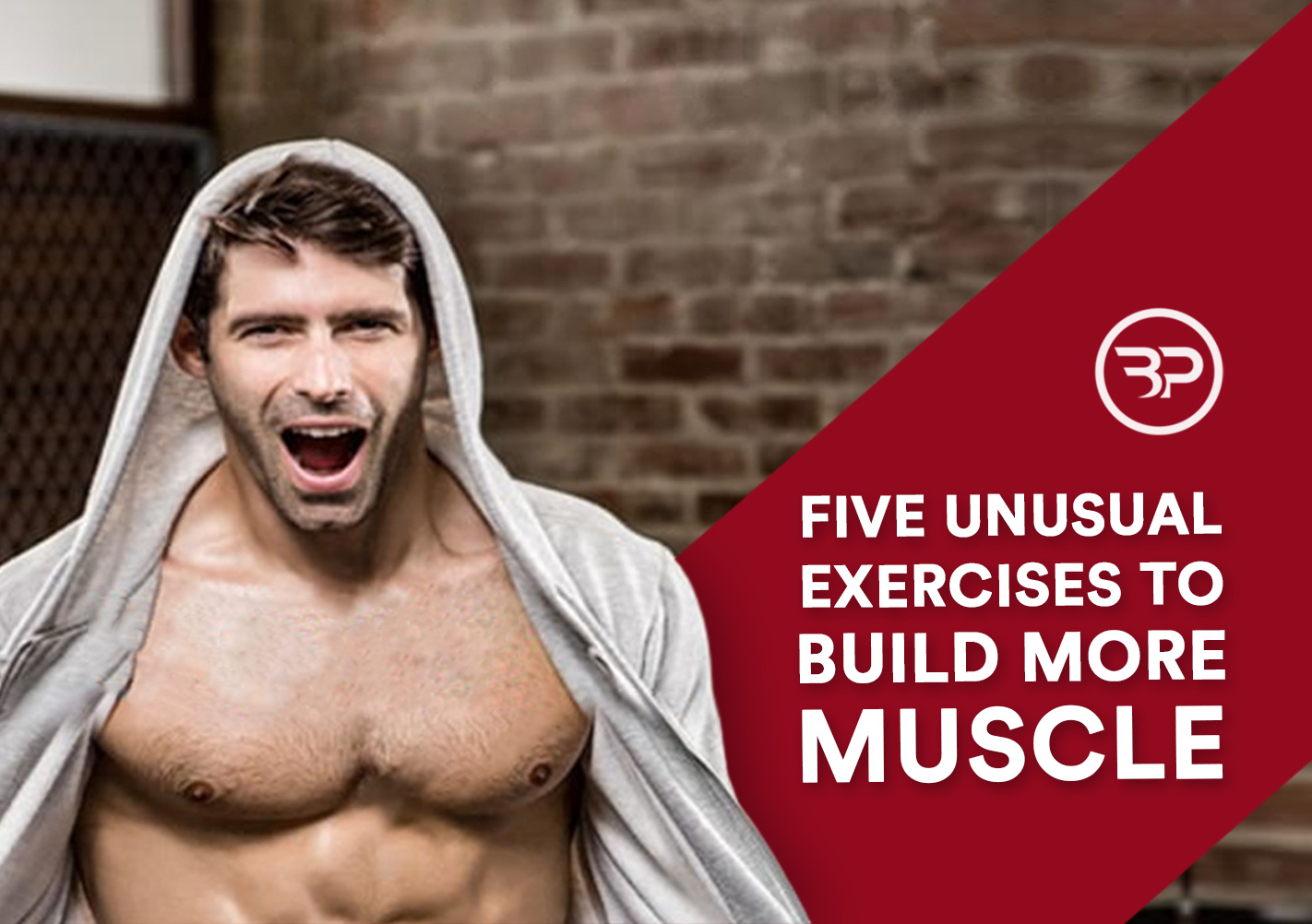Five Unusual Exercises to Build More Muscle
December 1, 2016
When it comes to building muscle, simplicity is the name of the game. Consistent and diligent application of your time and energy to the basics always yields the best results, as covered in my Five Day Muscle Fix.
Big deal. Who could disagree? But are you bored by the preceding paragraph. I am!
Which brings me to the point of this article:
Sometimes simplicity needs a kick in the ass! You’ll bust through plateaus to make training exciting again with these unusual exercises.
When simplicity is combined with exercise science, the sky’s the limit. In this article, you’ll discover some unorthodox exercise modifications that substitute and complement the basics. You’ll also find detailed explanations of when and why you should implement them.
1) Cable Fly to Pullover
What it replaces: Any traditional dumbbell fly, flat or incline.
Why it’s better: Naturally, dumbbells are limited by gravity. Draw a simple free body diagram and you’ll be quick to notice that tension drops drastically throughout the movement as a lifter approaches the terminal portion of the movement. If you’re not a physics nerd like me, the previous sentence can be translated to “dumbbell flies aren’t that great”.
We can overcome this by using cables, which take advantage of simple pulley systems to expand the resistance curve of a given movement. By introducing a dynamic isometric contraction on top of the movement, you can choose to activate both the upper and lower fibers of the chest musculature.
The combination of flexibility and efficacy of this exercise makes it a no-brainer for anyone looking to pack some muscle onto their chest. <<cough* cough>>* “I’m talking to you” <>
When to use it: This movement is a tremendous priming and finishing movement. If you struggle to “feel” your chest during your workouts, kick things off with a few sets of these bad boys. Doing so will help develop a solid mind muscle connection. That same connection will translate to optimized performance in your traditional compound presses later in your workout. This movement is also a fine choice for a finisher. You can accrue some serious metabolic stress in your chest by completing 2-3 sets to complete technical failure. The pump will be painful. You’ve been warned!
2) Barbell Rows with Handle Attachment
What it replaces: Overhand/Underhand Grip Barbell Rows
Why it’s better: The human shoulder is strongest when in a neutral position. By strapping a couple of handles onto a barbell, you can prevent aggravating that nagging shoulder injury while still directly targeting the musculature of the back. Introducing the handles to the mix increases the total range of motion of the movement. This allows for a stronger and more complete contraction at the top of the movement. Instead of the bar hitting your body to stop the rep, you can squeeze out an extra few inches of movement. None of the benefits of a traditional barbell row are lost in this movement. You can still focus on upper or lower back musculature by changing the bar path slightly. Row to your waist to drill your low lats, and pull to your chest to hit upper lats, traps, and rhomboids.
When to use it: Anyone with a history of shoulder pain or impingement will find this exercise incredibly effective. If you have healthy shoulders, you’ll still be able to take advantage of the extra range of motion and up the intensity of traditional rowing movements with this variation.
3) Asymmetrical Band Pull Aparts
What it complements: Rear Delt Work, Horizontal Pressing work.
Why it’s effective: There are not a whole lot of people walking this earth with symmetrically developed deltoids. More specifically, posterior delt development is lacking in just about everyone, serious and novice lifters alike.
Take a quick look at the way rear delts are typically trained and it all makes sense. 99.9% of lifters fall into one of two categories, those who don’t train rear delts at all, and those who train them in one plane of motion for a few sets and call it good. Not only can this lead to injury down the road, but a truly aesthetic physique does not have any weaknesses. To fully develop the posterior deltoids, it is imperative to train them according to their fiber orientation, and with adequate frequency and intensity to elicit growth. This movement is killer because it introduces both accommodating resistance AND a typically untapped plane of motion to stimulate more muscle.
When to use them: This movement is best performed before any horizontal OR vertical pressing work to set the scaps and stabilize the shoulder girdle for pain-free performance. Shoot for 3-4 sets carried out to failure, and enjoy the extra stability and size in your shoulders.
4) Incline Trap Raises
What it complements: Shrugs, Rear Delt Work
Why it’s effective: As gym rats, we’re over reliant on staple exercises such as shrugs. Ask anyone how to work their traps and you’re guaranteed to be recommended a heavy dosage of shrugs. But, the traps do a whole lot more than elevate the scapulae. They can retract, depress, AND elevate the scapulae depending on what plane of motion a force is applied in.
This movement takes advantage of that fact and can be used to target each of those movements. This is undoubtedly THE best overall trap isolation exercise. Watch the video carefully, the intricacies of the movement are the most important part. Weight is irrelevant in this exercise (check out my 7.5 pound dumbbells 😉 Your focus should be on movement quality, one of the key tenants in my Five Day Muscle Fix course.
When to use it: This movement makes a perfect pairing with a heavy duty shrug exercise like weighted carries and trap bar shrugs. Focus on squeezing your traps and rhomboids as hard as possible to get the most out of this one.
5) Hamstring Reverse Plank
What it complements: Any posterior-chain dominant work.
Why they’re effective: The hamstrings do a lot in the human body. They are incredibly powerful fast twitch muscles that also play an integral role in determining your posture and long term orthopedic health. They are the counterbalance to your quads and should be trained with the same tenacity to avoid any strength discrepancies between the two muscle groups. Plus, they look really good. But who cares about that ,right?
Using this exercise’s isometric contraction at the extreme of your hamstrings’ strength curve, recruits motor units that are typically only used during the most strenuous hip extension based movements. People don’t spend a whole lot of time at the extremes of a muscle’s range of motion. But that is where the most potential for growth exists.
When to use them: This is a great priming movement on your posterior dominant leg days. Hit three sets of max isometric hammy planks and then go rip some deads and enjoy the extra activation. If you really want to bring the pain, set up a quick three exercise circuit to wrap up your leg training. I like to throw three sets of prone hamstring curls, straight leg dumbbell deads, and hammy planks to failure at the end of my posterior dominant leg day. This maximizes metabolic stress without having to worry about nuking my Central Nervous System with heavy weight. Remember, metabolic stress is one of two main precursors for growth.
There you have it. Five exercises that you probably didn’t even know existed, that are about to rock your world. Try them out to add spice to your workouts and keep yourself on track!
Abo ut Ian
ut Ian
Ian is a highly sought after coach who specializes in building aesthetic physiques. His mission is to educate and empower his clients and readers alike, so they can take control of their own health and fitness. He currently resides in Washington state, and really likes dogs. Join the Five Day Muscle Fix to simplify the muscle building process and start making the gains you deserve.









Hey Ian, great read! It’s time for me to change few things in my program so I’ll go with your ideas. Thanks for sharing!